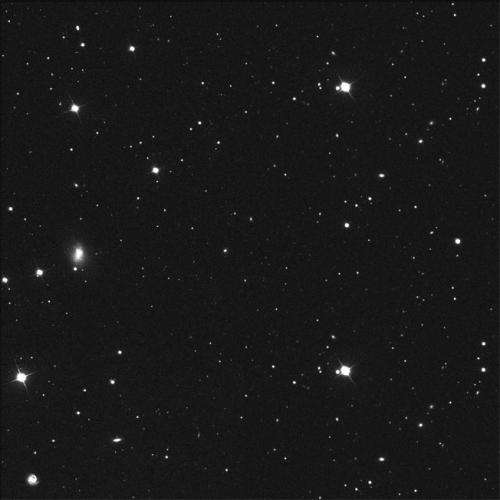April 9, 2014 report
Study of galaxy Segue 1 suggests it may be a fossil from the early universe

(Phys.org) —A trio of space researchers studying the galaxy Segue 1 has found that its red giant stars are made mostly of hydrogen and helium, with very few heavy elements, suggesting the galaxy stopped evolving not long after its formation. In their paper uploaded to the preprint sever arXiv (and soon to be published in Astrophysical Journal) the team describes observation data they've obtained regarding the galaxy and why what they've found might mean Segue 1 is the oldest observable galaxy in the night sky.
Scientists have known about Segue 1 for some time—it's both close to us (just 75,000 light years away) and very small, with just few hundred stars. In this new effort, Anna Frebel with MIT, Joshua Simon with Carnegie Mellon University and Evan Kirby with the University of California studied the makeup of red giants in Segue 1 and found they are made up mostly of hydrogen and helium. This implies that the stars came about due to the explosions of massive stars—prior research has shown that it's smaller star explosions that result in new stars forming heavy with metals (because the smaller stars create the heavier elements). Prior research has also shown that higher mass stars tend to blow up at a much younger age than low mass stars. Also when stars explode in general, they release material that winds up being used in new star formation. As the process repeats, more stars with heavy metals are created. But not Segue 1—for some reason the evolution process simply stopped, leaving the galaxy in very nearly the same condition it was shortly after forming. Why this happened is a mystery, though there is one theory—it's based on reionization.
Reionization theory suggests that shortly after the universe was born, ionized gasses began to cool allowing the formation of atoms and eventually stars. Those stars eventually blew up releasing radiation that served as fuel for more reionization. New stars cannot form from ionized gasses, of course, so if certain parts of space had stars that caused a lot of reionization, the creation of new stars would have been impossible—the evolution of such a galaxy would simply stop.
Thus far, Segue 1 is the only such galaxy to have been found, but if the reionization theory is correct, it's likely there are many more, researchers just can't see them because they are too far away.
More information: Segue 1: An Unevolved Fossil Galaxy from the Early Universe, arXiv:1403.6116 [astro-ph.GA] arxiv.org/abs/1403.6116
Abstract
We present Magellan/MIKE and Keck/HIRES high-resolution spectra of six red giant stars in the dwarf galaxy Segue 1. Including one additional Segue 1 star observed by Norris et al. (2010), high-resolution spectra have now been obtained for every red giant in Segue 1. Remarkably, three of these seven stars have metallicities below [Fe/H] = -3.5, suggesting that Segue 1 is the least chemically evolved galaxy known. We confirm previous medium-resolution analyses demonstrating that Segue 1 stars span a metallicity range of more than 2 dex, from [Fe/H] = -1.4 to [Fe/H] = -3.8. All of the Segue 1 stars are alpha-enhanced, with [alpha/Fe] ~ 0.5. High alpha-element abundances are typical for metal-poor stars, but in every previously studied galaxy [alpha/Fe] declines for more metal-rich stars, which is typically interpreted as iron enrichment from supernova Ia. The absence of this signature in Segue 1 indicates that it was enriched exclusively by massive stars. Other light element abundance ratios in Segue 1, including carbon-enhancement in the three most metal-poor stars, closely resemble those of metal-poor halo stars. Finally, we classify the most metal-rich star as a CH star given its large overabundances of carbon and s-process elements. The other six stars show remarkably low neutron-capture element abundances of [Sr/H] < -4.9 and [Ba/H] < -4.2, which are comparable to the lowest levels ever detected in halo stars. This suggests minimal neutron-capture enrichment, perhaps limited to a single r-process or weak s-process synthesizing event. Altogether, the chemical abundances of Segue 1 indicate no substantial chemical evolution, supporting the idea that it may be a surviving first galaxy that experienced only one burst of star formation.
via NatureNews
Journal information: arXiv , Astrophysical Journal
© 2014 Phys.org




















